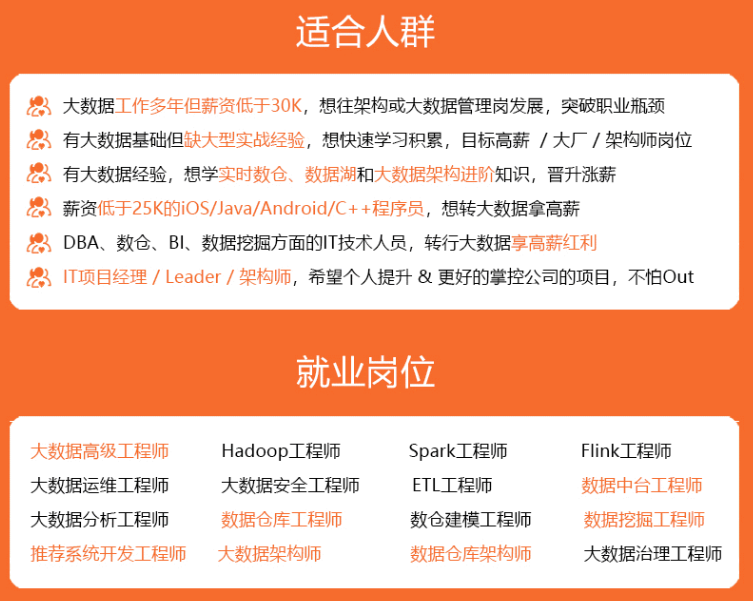
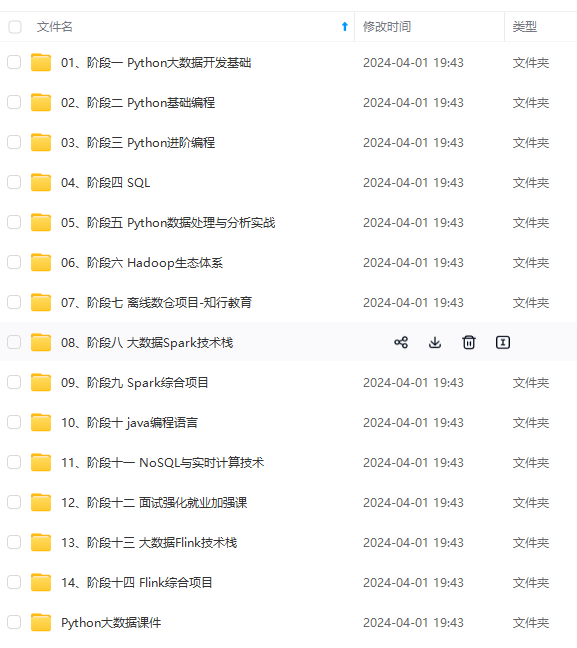
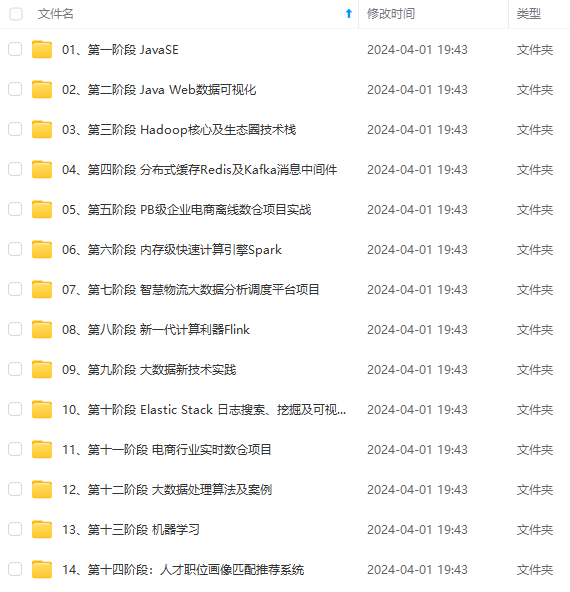
既有适合小白学习的零基础资料,也有适合3年以上经验的小伙伴深入学习提升的进阶课程,涵盖了95%以上大数据知识点,真正体系化!
由于文件比较多,这里只是将部分目录截图出来,全套包含大厂面经、学习笔记、源码讲义、实战项目、大纲路线、讲解视频,并且后续会持续更新
找数据集的时候我校验过,百度飞桨和github上的数据集是一样的。
github官网下载比较慢,可使用wget命令直接从百度飞桨的数据集地址下载,网速非常快。
原始数据如下图所示,使用nnunet要求结构化的数据集,使用前进行一个简单处理
root@worker04:~/data# tree data/KiTS19/origin
data/KiTS19/origin
|-- case_00000
| |-- imaging.nii.gz
| `-- segmentation.nii.gz
|-- case_00001
| |-- imaging.nii.gz
| `-- segmentation.nii.gz
|-- case_00002
| |-- imaging.nii.gz
| `-- segmentation.nii.gz
|-- case_00003
| |-- imaging.nii.gz
| `-- segmentation.nii.gz
......
下面是我根据nnunet中的dataset_conversion/Task040_KiTS.py修改的代码
import os
import json
import shutil
def save\_json(obj, file, indent=4, sort_keys=True):
with open(file, 'w') as f:
json.dump(obj, f, sort_keys=sort_keys, indent=indent)
def maybe\_mkdir\_p(directory):
directory = os.path.abspath(directory)
splits = directory.split("/")[1:]
for i in range(0, len(splits)):
if not os.path.isdir(os.path.join("/", \*splits[:i+1])):
try:
os.mkdir(os.path.join("/", \*splits[:i+1]))
except FileExistsError:
# this can sometimes happen when two jobs try to create the same directory at the same time,
# especially on network drives.
print("WARNING: Folder %s already existed and does not need to be created" % directory)
def subdirs(folder, join=True, prefix=None, suffix=None, sort=True):
if join:
l = os.path.join
else:
l = lambda x, y: y
res = [l(folder, i) for i in os.listdir(folder) if os.path.isdir(os.path.join(folder, i))
and (prefix is None or i.startswith(prefix))
and (suffix is None or i.endswith(suffix))]
if sort:
res.sort()
return res
base = "/root/data/data/KiTS19/origin"
out = "/root/data/nnUNet\_raw\_data\_base/nnUNet\_raw\_data/Task040\_KiTS"
cases = subdirs(base, join=False)
maybe_mkdir_p(out)
maybe_mkdir_p(os.path.join(out, "imagesTr"))
maybe_mkdir_p(os.path.join(out, "imagesTs"))
maybe_mkdir_p(os.path.join(out, "labelsTr"))
for c in cases:
case_id = int(c.split("\_")[-1])
if case_id < 210:
shutil.copy(os.path.join(base, c, "imaging.nii.gz"), os.path.join(out, "imagesTr", c + "\_0000.nii.gz"))
shutil.copy(os.path.join(base, c, "segmentation.nii.gz"), os.path.join(out, "labelsTr", c + ".nii.gz"))
else:
shutil.copy(os.path.join(base, c, "imaging.nii.gz"), os.path.join(out, "imagesTs", c + "\_0000.nii.gz"))
print(case_id,' done!')
json_dict = {}
json_dict['name'] = "KiTS"
json_dict['description'] = "kidney and kidney tumor segmentation"
json_dict['tensorImageSize'] = "4D"
json_dict['reference'] = "KiTS data for nnunet"
json_dict['licence'] = ""
json_dict['release'] = "0.0"
json_dict['modality'] = {
"0": "CT",
}
json_dict['labels'] = {
"0": "background",
"1": "Kidney",
"2": "Tumor"
}
json_dict['numTraining'] = 210
json_dict['numTest'] = 90
json_dict['training'] = [{'image': "./imagesTr/%s.nii.gz" % i, "label": "./labelsTr/%s.nii.gz" % i} for i in
cases[:210]]
json_dict['test'] = ["./imagesTs/%s.nii.gz" % i for i in
cases[210:]]
save_json(json_dict, os.path.join(out, "dataset.json"))
这里只是对数据集进行一个拷贝和重命名,不对原始数据进行修改。
运行代码后,整理好的数据集结构如下:
nnUNet_raw_data_base/nnUNet_raw_data/Task040_KiTS
├── dataset.json
├── imagesTr
│ ├── case_00000_0000.nii.gz
│ ├── case_00001_0000.nii.gz
│ ├── ...
├── imagesTs
│ ├── case_00210_0000.nii.gz
│ ├── case_00211_0000.nii.gz
│ ├── ...
├── labelsTr
│ ├── case_00000.nii.gz
│ ├── case_00001.nii.gz
│ ├── ...
dataset.json文件保存了训练集图像、训练集标签、测试集图像等信息。
预处理阶段会根据dataset.json读取图像,如果想要剔除某个病例,直接在dataset.json修改就好。
{
"description": "kidney and kidney tumor segmentation",
"labels": {
"0": "background",
"1": "Kidney",
"2": "Tumor"
},
"licence": "",
"modality": {
"0": "CT"
},
"name": "KiTS",
"numTest": 90,
"numTraining": 210,
"reference": "KiTS data for nnunet",
"release": "0.0",
"tensorImageSize": "4D",
"test": [
"./imagesTs/case_00210.nii.gz",
"./imagesTs/case_00211.nii.gz",
.....
],
"training": [
{
"image": "./imagesTr/case_00000.nii.gz",
"label": "./labelsTr/case_00000.nii.gz"
},
{
"image": "./imagesTr/case_00001.nii.gz",
"label": "./labelsTr/case_00001.nii.gz"
},
......
]
}
提前准备三个文件夹,分别存放数据集、预处理数据和训练结果,配置好环境变量,具体细节可以参考我的第一篇博文。
2.数据预处理
nnUnet可以读取CT图像的模态信息、体素间距、灰度分布,自动进行重采样、裁剪以及归一化。

nnUnet图像分割的自动方法配置(https://www.nature.com/articles/s41592-020-01008-z)
重采样
不同时期,不同仪器的CT扫描仪,采样得到的CT图像具有不同的空间分辨率,重采样的目的是将所有的病例采样到相同的空间分辨率(体素间距)。
nnUnet的数据预处理preprocess自带重采样,但我试过两次之后效果并不好,重采样之后的图像尺寸太大了,于是我按照冠军论文里的方法自己写了个重采样,将所有病例的体素间距重采样为 3.22 x 1.62 x 1.62.
另外,论文中有提到case15和case37标签的错误,本来打算去掉,不过后来我去KiTS19的github官网看了一下,官方已经作了修正。
import numpy as np
import SimpleITK as sitk
def transform(image,newSpacing, resamplemethod=sitk.sitkNearestNeighbor):
# 设置一个Filter
resample = sitk.ResampleImageFilter()
# 初始的体素块尺寸
originSize = image.GetSize()
# 初始的体素间距
originSpacing = image.GetSpacing()
newSize = [
int(np.round(originSize[0] \* originSpacing[0] / newSpacing[0])),
int(np.round(originSize[1] \* originSpacing[1] / newSpacing[1])),
int(np.round(originSize[2] \* originSpacing[2] / newSpacing[2]))
]
print('current size:',newSize)
# 沿着x,y,z,的spacing(3)
# The sampling grid of the output space is specified with the spacing along each dimension and the origin.
resample.SetOutputSpacing(newSpacing)
# 设置original
resample.SetOutputOrigin(image.GetOrigin())
# 设置方向
resample.SetOutputDirection(image.GetDirection())
resample.SetSize(newSize)
# 设置插值方式
resample.SetInterpolator(resamplemethod)
# 设置transform
resample.SetTransform(sitk.Euler3DTransform())
# 默认像素值 resample.SetDefaultPixelValue(image.GetPixelIDValue())
return resample.Execute(image)
注意重采样的插值方法,我试过SimpleITK自带的多种插值方法,线性插值,三次插值以及B样条,比较发现B样条的效果是最好的。
因此,image采用sitk.sitkBSpline插值,segment采用sitk.sitkNearestNeighbor插值。
如果感兴趣可以自己尝试一下不同的插值方法,或者使用scipy等其他工具包进行重采样。
data_path = "/root/data/nnUNet\_raw\_data\_base/nnUNet\_raw\_data/Task040\_KiTS/imagesTr"
for path in sorted(os.listdir(data_path)):
print(path)
img_path = os.path.join(data_path,path)
img_itk = sitk.ReadImage(img_path)
print('origin size:', img_itk.GetSize())
new_itk = transform(img_itk, [3.22, 1.62, 1.62], sitk.sitkBSpline) # sitk.sitkLinear
sitk.WriteImage(new_itk, img_path)
print('images is resampled!')
print('-'\*20)
label_path = "/root/data/nnUNet\_raw\_data\_base/nnUNet\_raw\_data/Task040\_KiTS/labelsTr"
for path in sorted(os.listdir(label_path)):
print(path)
img_path = os.path.join(label_path,path)
img_itk = sitk.ReadImage(img_path)
print('origin size:', img_itk.GetSize())
new_itk = transform(img_itk, [3.22, 1.62, 1.62])
sitk.WriteImage(new_itk, img_path)
print('labels is resampled!')
下面开始介绍nnUnet的数据预处理方法:
输入指令:
python nnunet/experiment_planning/nnUNet_plan_and_preprocess.py -t 40 --verify_dataset_integrity
verify_dataset_integrity这里不再赘述,主要是根据验证数据集结构,第一次运行的时候最好还是加上。
裁剪
裁剪的目的是裁去黑边,减少像素值为0的边缘区域,裁剪的时候保持空间分辨率等信息不变。
def crop(task_string, override=False, num_threads=default_num_threads):
# 输出目录:'/root/data/nnUNet\_raw\_data\_base/nnUNet\_cropped\_data/Task040\_KiTS'
cropped_out_dir = join(nnUNet_cropped_data, task_string)
maybe_mkdir_p(cropped_out_dir)
if override and isdir(cropped_out_dir):
shutil.rmtree(cropped_out_dir)
maybe_mkdir_p(cropped_out_dir)
splitted_4d_output_dir_task = join(nnUNet_raw_data, task_string)
lists, _ = create_lists_from_splitted_dataset(splitted_4d_output_dir_task) # 创建裁剪列表
imgcrop = ImageCropper(num_threads, cropped_out_dir)
imgcrop.run_cropping(lists, overwrite_existing=override)
shutil.copy(join(nnUNet_raw_data, task_string, "dataset.json"), cropped_out_dir)
create_lists_from_splitted_dataset加载所有的训练集的图像地址,lists一共有210个元素,每个元素包含图像和标签。
def create\_lists\_from\_splitted\_dataset(base_folder_splitted):
lists = []
json_file = join(base_folder_splitted, "dataset.json")
with open(json_file) as jsn:
d = json.load(jsn)
training_files = d['training']
num_modalities = len(d['modality'].keys())
for tr in training_files:
cur_pat = []
for mod in range(num_modalities):
cur_pat.append(join(base_folder_splitted, "imagesTr", tr['image'].split("/")[-1][:-7] +
"\_%04.0d.nii.gz" % mod))
cur_pat.append(join(base_folder_splitted, "labelsTr", tr['label'].split("/")[-1]))
lists.append(cur_pat)
return lists, {int(i): d['modality'][str(i)] for i in d['modality'].keys()}
重点是这两个函数:
imgcrop = ImageCropper(num_threads, cropped_out_dir)
imgcrop.run_cropping(lists, overwrite_existing=override)
ImageCropper是一个类,包含10个方法。
重点是crop和run_cropping两个方法:
- crop:裁剪到非零区域,返回data, seg, properties
- run_cropping:执行裁剪操作,并且将结果保存为.npz文件(包含data和seg),将size, spacing, origin, classes, size_after_cropping 等属性保存在.pkl文件。

但是执行代码时,发现裁剪前后尺寸没有变化,可能是因为图像没有什么黑边
# 裁剪的时候seg!=None
def crop(data, properties, seg=None):
shape_before = data.shape # 原始尺寸
data, seg, bbox = crop_to_nonzero(data, seg, nonzero_label=-1) # 裁剪结果
shape_after = data.shape # 裁剪尺寸
print("before crop:", shape_before, "after crop:", shape_after, "spacing:",
np.array(properties["original\_spacing"]), "\n")
properties["crop\_bbox"] = bbox
properties['classes'] = np.unique(seg)
seg[seg < -1] = 0
properties["size\_after\_cropping"] = data[0].shape
return data, seg, properties
数据分析
收集上一步裁剪得到的图像信息(尺寸、体素间距、灰度分布),为当前任务制定合适的训练计划(plan)
# '/root/data/nnUNet\_raw\_data\_base/nnUNet\_cropped\_data/Task040\_KiTS'
cropped_out_dir = os.path.join(nnUNet_cropped_data, t)
# '/root/data/nnUNet\_preprocessed/Task040\_KiTS'
preprocessing_output_dir_this_task = os.path.join(preprocessing_output_dir, t)
# we need to figure out if we need the intensity propoerties. We collect them only if one of the modalities is CT
dataset_json = load_json(join(cropped_out_dir, 'dataset.json'))
modalities = list(dataset_json["modality"].values())
collect_intensityproperties = True if (("CT" in modalities) or ("ct" in modalities)) else False
dataset_analyzer = DatasetAnalyzer(cropped_out_dir, overwrite=False, num_processes=tf) # this class creates the fingerprint
_ = dataset_analyzer.analyze_dataset(collect_intensityproperties) # this will write output files that will be used by the ExperimentPlanner
maybe_mkdir_p(preprocessing_output_dir_this_task)
shutil.copy(join(cropped_out_dir, "dataset\_properties.pkl"), preprocessing_output_dir_this_task)
shutil.copy(join(nnUNet_raw_data, t, "dataset.json"), preprocessing_output_dir_this_task)
分析得到的dataset_properties.pkl结果如下:

创建数据指纹
根据上一步得到的数据集信息,针对不同的训练任务,制定合适的训练计划(plan)
if planner_3d is not None:
if args.overwrite_plans is not None:
assert args.overwrite_plans_identifier is not None, "You need to specify -overwrite\_plans\_identifier"
exp_planner = planner_3d(cropped_out_dir, preprocessing_output_dir_this_task, args.overwrite_plans,
args.overwrite_plans_identifier)
else:
exp_planner = planner_3d(cropped_out_dir, preprocessing_output_dir_this_task)
exp_planner.plan_experiment()
if not dont_run_preprocessing: # double negative, yooo
exp_planner.run_preprocessing(threads)
if planner_2d is not None:
exp_planner = planner_2d(cropped_out_dir, preprocessing_output_dir_this_task)
exp_planner.plan_experiment()
if not dont_run_preprocessing: # double negative, yooo
exp_planner.run_preprocessing(threads)
预处理执行完毕,得到如下处理结果:
nnUNet_preprocessed文件夹下
|-- Task040_KiTS
|-- dataset.json
|-- dataset_properties.pkl
|-- gt_segmentations
|-- nnUNetData_plans_v2.1_2D_stage0
|-- nnUNetData_plans_v2.1_stage0
|-- nnUNetPlansv2.1_plans_2D.pkl
|-- nnUNetPlansv2.1_plans_3D.pkl
`-- splits_final.pkl
这里生成的文件都可以打开来看看,对预处理方法和数据指纹有一个了解
- dataset.json在数据获取阶段产生
- daset_properties为数据的 size, spacing, origin, classes, size_after_cropping 等属性
- gt_segmentations为图像分割标签
- nnUNetData_plans_v2.1_2D_stage0和nnUNetData_plans_v2.1_stage0是预处理后的数据集
- splits_final.pkl是五折交叉验证划分的结果,一共210个病人,42为一折
- nnUNetPlansv2.1_plans*.pkl为训练计划,参考官方文档中的edit_plans_files.md可进行编辑
以nnUNetPlansv2.1_plans_3D.pkl为例,

3.模型训练
一行代码开始训练,执行过程以及调参可以参考我的博客nnUnet代码解读–模型训练
python nnunet/run/run_training.py CONFIGURATION TRAINER_CLASS_NAME TASK_NAME_OR_ID FOLD # 格式
python nnunet/run/run_training.py 3d_fullres nnUNetTrainerV2 40 1
训练开始后,训练日志和训练结果记录在nnUNet_trained_models/nnUNet/3d_fullres/Task040_KiTS文件夹下
UNetTrainer__nnUNetPlansv2.1
├── fold_1
│ ├── debug.json
│ ├── model_best.model
│ ├── model_best.model.pkl
│ ├── model_final_checkpoint.model
│ ├── model_final_checkpoint.model.pkl
│ ├── postprocessing.json
│ ├── progress.png
│ ├── training_log_2022_5_4_12_06_14.txt
│ ├── training_log_2022_5_5_10_30_05.txt
│ ├── validation_raw
│ └── validation_raw_postprocessed

训练过程Loss曲线以及在线计算的Dice曲线
这里我想补充一下nnUnet的评价指标
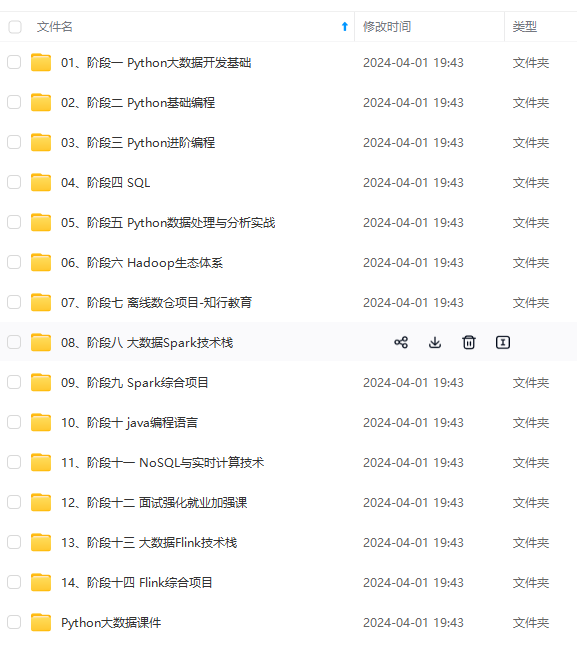
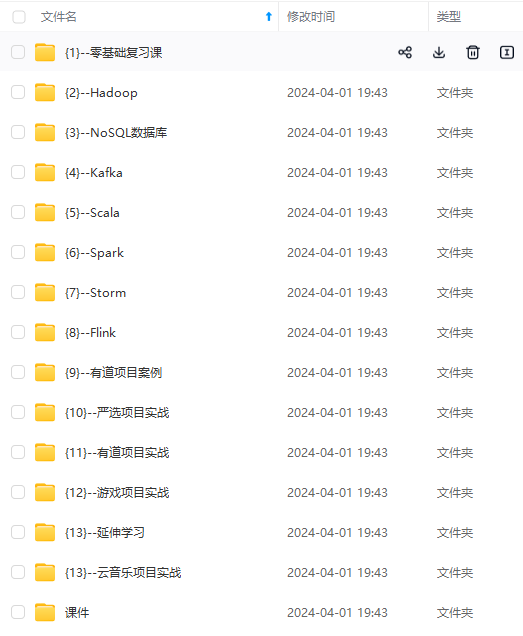
网上学习资料一大堆,但如果学到的知识不成体系,遇到问题时只是浅尝辄止,不再深入研究,那么很难做到真正的技术提升。
一个人可以走的很快,但一群人才能走的更远!不论你是正从事IT行业的老鸟或是对IT行业感兴趣的新人,都欢迎加入我们的的圈子(技术交流、学习资源、职场吐槽、大厂内推、面试辅导),让我们一起学习成长!
── validation_raw
│ └── validation_raw_postprocessed

训练过程Loss曲线以及在线计算的Dice曲线
>
> 这里我想补充一下nnUnet的评价指标
>
>
>
[外链图片转存中...(img-3xdhRFFo-1715280765839)]
[外链图片转存中...(img-VZyMVPTr-1715280765840)]
**网上学习资料一大堆,但如果学到的知识不成体系,遇到问题时只是浅尝辄止,不再深入研究,那么很难做到真正的技术提升。**
**[需要这份系统化资料的朋友,可以戳这里获取](https://bbs.csdn.net/forums/4f45ff00ff254613a03fab5e56a57acb)**
**一个人可以走的很快,但一群人才能走的更远!不论你是正从事IT行业的老鸟或是对IT行业感兴趣的新人,都欢迎加入我们的的圈子(技术交流、学习资源、职场吐槽、大厂内推、面试辅导),让我们一起学习成长!**






















 757
757











 被折叠的 条评论
为什么被折叠?
被折叠的 条评论
为什么被折叠?








